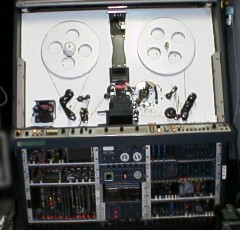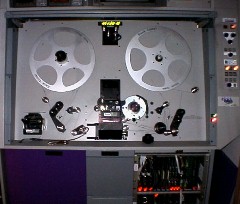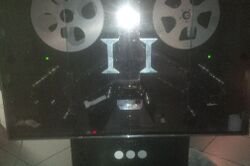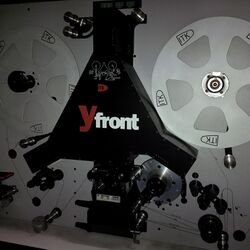Company:Cintel
| Type | Private |
|---|---|
| Industry | Digital cinema |
| Fate | Liquidation; assets and intellectual property acquired by Blackmagic Design |
| Founded | 1927 |
| Founder | John Logie Baird |
| Defunct | July 24, 2012 |

Cintel was a British digital cinema company founded in 1927 by John Logie Baird and based in Ware, Hertfordshire. The early company was called Cinema Television Ltd. Cinema Television was sold to J Arthur Rank Organization renamed Rank Cintel in 1958. It specialized in the design and manufacture of professional post-production equipment, for transcribing film into video or data formats. It was formerly part of the Rank Organisation.[1] Along with a line of telecines, Rank Cintel made 3 tube RGB color video projectors in the 1960s.
Their main products were based on either cathode ray tube (CRT) Flying-spot scanner or charge coupled device (CCD) technology and include, like the diTTo, diTTo Evolution & dataMill film scanners, Millennium II, Millennium HD & C-Reality & DSX telecines, imageMill 1 & 2 image processing system. The CRT tubes were made by Rank and Brimar. In September 2002 Cintel purchased ITK - Innovation TK Ltd. ITK held a number of patents for features used in Cintel products and also made the competitive unit the Millennium telecine. ITK founded in 1994, also made upgrade products include the TWiGi system, the SCAN’dAL, and the Y-Front.[2][3][4]



Many movies and TV shows for TV were transferred from film to TV on Cintel Telecines. Cintel saw reduced sales with the introduction of Spirit DataCine in 1996. The business was in administration until its announced liquidation. On July 24, 2012 Blackmagic Design acquired the assets of Cintel.[5]
History
- 1927 John Logie Baird founds the Baird Television Company, which later becomes Cinema-Television and then Cintel.[6]
- During the Second World War, Cintel supplies thousands of specialist photoelectric cells, and cathode ray tubes for the war effort.
- 1950 The first flying spot telecine was installed at the BBC's Lime Grove Studios.
- 1958 Cinema-Television Limited was renamed Rank Cintel Limited.
- 1946 TMk1 shown using a polygonal prism system, it was the first 35mm continuous Motion Flying Spot Telecine.
- 1964 The model Mk II Telecine with twin lens was shown it supported both 35mm and 16mm.
- 1967 The Flying Spot Color Slide Scanner made, with two slides with manual changeover.
- 1975 The Model Mk III used a new system called jump scan Analog.
- 1977 The first Rank Cintel Flying Spot Scanner was introduced into North America by MPV, (Motion Picture Video Corporation, Toronto) and the first colorist and pan & scan operator was the then president Bob Sher.
- 1977 Mk IIIC was the next generation Digiscan, with improvements
- 1980 Cintel introduced the Ferrit Sound Follower for double system separate magnetic sound.
- 1982 ADS-1 a CCD Telecine shown
- 1987 the model MK IIIB was shown it used a progressive scan CRT and a Digiscan system to make SDTV.
- 1987 ADS-2 a CCD Telecine shown
- 1987 MK3C Digiscan with 4 4:2:2 outputs and Ref Frame
- 1988 ADS-8 CCD slide scanner with standard Kodak slide carousels.
- 1989 the Ursa 4:2:2 with D1 color space output was shown.
- 1993 the Ursa Gold with 4:4:4 output was shown.
- 1993 the Rank Cintel Mk III with HDTV high definition was shown.
- 1997 the Ursa Diamond, with many third-party improvements added was shown.
- OSCAR was added as an optical dust and scratch removal system for their telecines.
- C-Reality was a HD telecine with a Data option for DI work.
- 2002 the DSX telecine HD and Data was shown.
- 2002 Cintel acquired Innovation TK, including the Millennium HD and Data Telecine.
- 2003 Cintel launches GRACE, an internal Film Grain Reducer option for C-Reality and DSX machines
- Millennium II
- 2004 they shown the dataMill fast data scanner based on Millennium 2 technology
- 2004 the GRACE system was shown as an external film grain reducer
- Millennium HD
- ImageMill 1 (video)
- 2005 diTTo - was shown as a low end 2K data scanner, with a 3K native sensor
- diTTo Evolution
- ImageMill 2 ( data)
- OCEAN controller

Innovation TK

Innovation TK Ltd, ITK, was founded in 1994, Innovation TK, the key engineer and manager was Stuart Hunt, who was design engineer for Cintel. Innovation TK designed and patented product to improve Cintel's flying-spot telecines, like the TWiGi system, the SCAN'dAL, and the Y-Front. Later TWiGi and SCAN'dAL became standard features used on Cintel's URSA Diamond. Later ITK designed and built their own telecine the: Millennium Machine and Millennium Lite. In 2002 Cintel acquired Innovation TK, including the Millennium HD and Millennium Data Telecine.[7]
See also
- Test film
- 3D LUT
- Color motion picture film
- Color suite
- Da Vinci Systems for color grading and video editing systems.
- Pandora International
References
- ↑ earlytelevision.org, cathode ray tube Rank Cintel
- ↑ shots.net, Cintel snaps up ITK, 18 September 2002
- ↑ highbeam.com, Cintel purchases ITK, 2002
- ↑ broadcastnow.co.uk Cintel buys ITK assets, 16 September, 2002
- ↑ blackmagicdesign.com cintel
- ↑ Eye of the World: John Logie Baird and Television
- ↑ Broadcast Now, Cintel buys out Innovation TK, 18 September, 2002
- Digital Content Producer Millimeter, A Brief History of Film-to-Tape: With DTV and HDTV-What's Next?, Feb 1, 1998, by .W. Leitner
- A Brief History for Colorists from finalcolor.com
- The History of Television, 1942 to 2000 By Albert Abramson, Christopher H. Sterling
External links
 |

